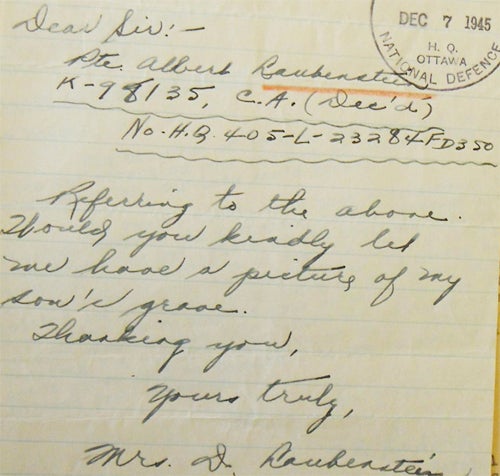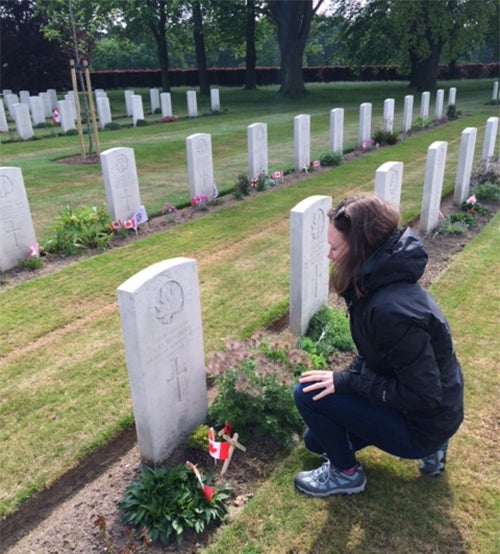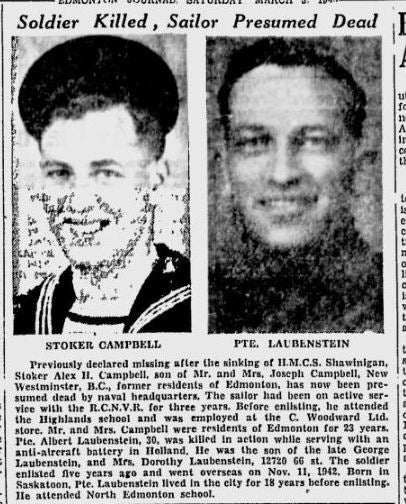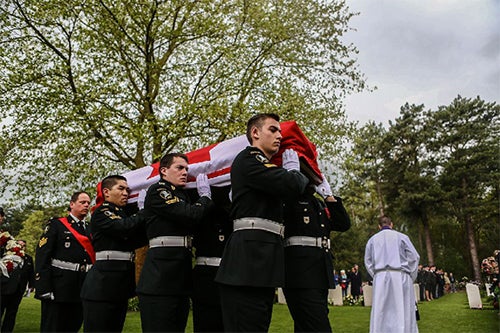
Liberating the Netherlands: The story behind a Canadian soldier killed in battle
Waterloo history student honours Private Albert Laubenstein whose remains were found last year - almost 70 years after he was killed in World War Two

Waterloo history student honours Private Albert Laubenstein whose remains were found last year - almost 70 years after he was killed in World War Two
By Heather Whiteside University of WaterlooHeather Whiteside is a University of Waterloo history student who was selected to take part in the Canadian Battlefields Foundation academic study tour of Europe in early May. This year’s study tour coincided with the 70th Anniversary of the liberation of the Netherlands at the end of the Second World War.
King Willem-Alexander and Queen Maxima of the Netherlands will visit the University of Waterloo on May 28. The royal couple will tour research labs at the Institute for Quantum Computing and announce an historic scholarship program celebrating the 70th anniversary of the liberation of the Netherlands.
The battlefields study tour was co-led by Waterloo history professor Geoffrey Hayes:
“Heather spoke of Private Laubenstein, a fellow from a poor farm family who joined to learn a trade but died on a horrible cold battlefield in the Netherlands in January 1945. His remains were finally recovered last year, decades after his mother wrote the army asking for a photograph of his grave.”

This letter was written in 1945 by Dorothy Laubenstein, mother of Private Albert Laubenstein, who was killed in action during the campaign to liberate the Netherlands. Private Laubenstein's remains were found on a river bank in the Netherlands in 2014. The Canadian solider was given a military burial in May 2015.
Today, I had the privilege of sharing the story of Private Albert Laubenstein with our group. It draws together a colourful Canadian soldier, a hobbyist here in the Netherlands, and us, the people who are remembering the Second World War.
The story begins with Govert de Lorm, as he was scanning the banks of the Mass River near Sprang-Capelle with a metal detector. He was used to finding all sorts of treasures leftover from the war. What he wasn’t used to finding were the actual remains of soldiers. Last June, he came across a tibia, fibula, and femur. Thanks to the detailed dental records kept by the Canadian Army, and the fact that this particular gentleman never seemed to brush his teeth, the Royal Canadian Dental Corps were able to identify the remains.
And that’s where we meet Private Laubenstein. His story, at least for me, really emphasized the fact that each and every man buried in the cemeteries we’ve been visiting had a personality, a character, and in many cases, plans for how they wanted to spend their time here in Europe as well as their time back at home after the war.

University of Waterloo history student Heather Whiteside pays her respects at Groesbeek Canadian War Cemetery in the Netherlands.
Private Laubenstein was born in Saskatoon, Saskatchewan, on March 28, 1914, the eldest son of George and Dorothy Laubenstein. Growing up, he played goal in hockey, catcher in baseball, and defense in soccer. After graduating Grade 8, Albert began working as a farm labourer across the Western provinces, before settling in Edmonton.
In July 1940, he decided to enlist at Victoria and was sent overseas to Liverpool in 1941. In his records, he notes his interest in being trained in a trade, specifically in order to become a sheet metal worker upon his return to Canada. Private Laubenstein spent much of the next three years with coastal or anti-aircraft batteries, landing at Dieppe as a gunner with the 3rd Light Anti Aircraft.
This, however, isn’t what stands out most about Laubenstein’s story. In December 1941, he was sentenced to 21 days detention for being insolent to a corporal, and also forfeited 21 days’ pay. In May 1943, he was court martialled for selling cigarettes, but challenged the charges by pointing out that he had been only selling them to civilians, and not other soldiers.

Newspaper clipping with photos of Private Laubenstein (right) and death notice. Photo credit: Credit: Commonwealth War Graves Commission
In October 1943, Private Laubenstein was sent to the 4th Canadian Infantry Reinforcement Unit, but he made it exceedingly clear that he had no interest in being part of the Infantry. His file includes a note from a Personnel Selection officer claiming that Laubenstein “has had no infantry training outside of long route marches; says that he has never fired a Bren, a Sten, or a Tommy, and has never used grenades.” Private Laubenstein even went so far as to say that he would deliberately fail any TOETS given to him. In the end, the instructors decided that the best course of action would be for him to remain with the Artillery, since forcing him into duty with the Infantry would “only succeed in making him a disciplinary problem.”
Despite Private Laubenstein’s determination to avoid the Infantry, he was transferred from the Artillery in October 1944. He first joined the Rocky Mountain Rangers and then the Lincoln and Welland Regiment on January 9th, 1945. Private Laubenstein was killed at the battle of Kapelsche Veer on January 26th.
That’s where the story seemed to end, until last June. Thanks to de Lorm’s discovery, Private Laubenstein was finally buried on May 6th, 2015 at Bergen-Op-Zoom Canadian War Cemetery with military honours. His burial was made all the more special given how the timing coincided with the commemorative celebrations of the 70th anniversary of the liberation of the Netherlands. In a sense, Private Laubenstein has come to represent the many other Canadians who gave their lives there.

Members of the Lincoln and Welland Regiment participate in the internment for Private Albert Laubenstein at the Bergen-op-Zoom Canadian War Cemetery. credit: Veterans Affairs Canada
May they rest in peace.

Read more
Meet five exceptional Waterloo graduate students crossing the convocation stage as Class of 2025 valedictorians

Read more
The medal honours outstanding individuals across Canada who have made significant contributions to their communities

Read more
Waterloo welcomes emerging postdoctoral scholars to receive funding from Provost fellowship programs
The University of Waterloo acknowledges that much of our work takes place on the traditional territory of the Neutral, Anishinaabeg, and Haudenosaunee peoples. Our main campus is situated on the Haldimand Tract, the land granted to the Six Nations that includes six miles on each side of the Grand River. Our active work toward reconciliation takes place across our campuses through research, learning, teaching, and community building, and is co-ordinated within the Office of Indigenous Relations.